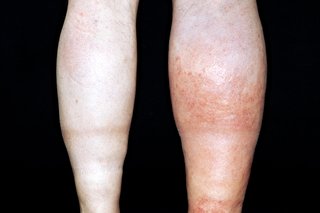How Do You Know if Youve Got a Blood Clot in Your Leg
DVT (deep vein thrombosis) is a blood clot in a vein, ordinarily the leg. DVT can be dangerous. Get medical assistance as presently every bit possible if y'all think you take DVT.
Urgent advice: Ask for an urgent GP appointment or get help from NHS 111 if:
Yous recollect yous have DVT.
Symptoms of DVT in the leg are:
- throbbing or cramping pain in ane leg (rarely both legs), usually in the dogie or thigh
- swelling in 1 leg (rarely both legs)
- warm skin effectually the painful area
- red or darkened skin around the painful area
- swollen veins that are difficult or sore when yous bear upon them
These symptoms tin likewise happen in your arm or tummy if that's where the blood jell is.
You tin can telephone call 111 or become help from 111 online.
What DVT in a leg can await like

Who is more than likely to get DVT
A DVT is more likely to happen if you:
- are over 60
- are overweight
- smoke
- take had DVT before
- accept the contraceptive pill or HRT
- have cancer or heart failure
- have varicose veins
In that location are also some temporary situations when you're at more run a risk of DVT. These include if you:
- are staying in or recently left hospital – especially if you cannot move around much (like after an operation)
- are confined to bed
- go along a long journey (more than 3 hours) by aeroplane, car or railroad train
- are meaning or if you've had a infant in the previous 6 weeks
- are dehydrated
Sometimes DVT tin happen for no obvious reason.
How DVT is diagnosed
If a physician thinks you have DVT, you should exist referred to infirmary inside 24 hours for an ultrasound scan. The scan shows whether blood is flowing unremarkably through the vein.
Y'all may also have an X-ray of the vein (venogram). For this, you will exist injected with a dye to show where the blood jell is.
Handling of DVT
You may accept an injection of an anticoagulant (blood thinning) medicine chosen heparin while you're waiting for an ultrasound scan to tell if you have a DVT.
Subsequently DVT is diagnosed, the chief treatment is tablets of an anticoagulant medicine, such as warfarin and rivaroxaban. You will probably take the tablets for at least iii months.
If anticoagulant medicines are not suitable, you may have a filter put into a large vein – the vena cava – in your tummy. The filter traps and stops a blood clot travelling to your eye and lungs.
A newer treatment involves breaking upward and sucking out the jell through a small tube in the vein. You lot usually need to accept anticoagulant medicine for several months after this treatment.
DVT in pregnancy is treated differently. It is treated with anticoagulant injections for the residuum of the pregnancy and until the infant is 6 weeks old. Read more well-nigh DVT in pregnancy.
Recovery from DVT
Some lifestyle measures will help you lot recover from DVT.
Afterward y'all leave hospital, you lot will be encouraged to:
- walk regularly
- keep your affected leg raised when you're sitting
- delay any flights or long journeys until at least 2 weeks afterwards you lot start anticoagulant medicine
Tips to prevent DVT
Do
-
stay a healthy weight
-
stay active – taking regular walks can assist
-
drink plenty of fluids to avoid dehydration – DVT is more likely if you're dehydrated
Don't
-
exercise not sit still for long periods of fourth dimension – get upwards and move around every hour or so
-
do not cantankerous your legs while you're sitting, it can restrict blood flow
-
do not fume – go back up to finish smoking
-
practice not drink lots of alcohol
Going on a long journey
If you're travelling for 3 hours or more than by plane, railroad train or car, there are things you can do during the journey to reduce your risk of DVT. These include drinking plenty of water and fugitive alcohol.
Notice out more tips to reduce your take a chance of travel-related DVT
Going into hospital
If you go into hospital, your healthcare team should cheque your risks of DVT.
If they retrieve you're more likely to get DVT, you may be given handling to prevent it, such as medicine or compression stockings (knee-high elastic socks that assistance your claret apportionment), while you're in hospital.
You lot may go along treatment later you go out hospital considering a claret jell can happen weeks later.
Yous tin also assistance protect yourself against DVT while yous're in hospital by:
- staying active and walking around if you can
- moving your toes (up and down) and ankles (in circles) if you have to stay in bed – your healthcare team may give you some exercises to do
Aid the states meliorate
Tell united states of america well-nigh your experience using wellness services.
Take our survey
Folio final reviewed: 23 October 2019
Next review due: 23 Oct 2022
Source: https://www.nhs.uk/conditions/deep-vein-thrombosis-dvt/
0 Response to "How Do You Know if Youve Got a Blood Clot in Your Leg"
Post a Comment